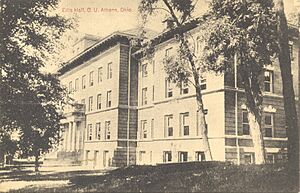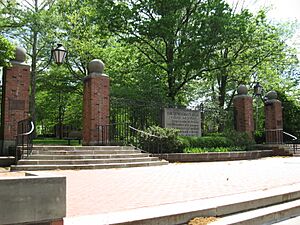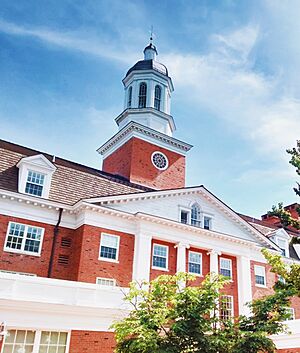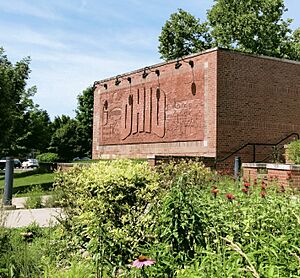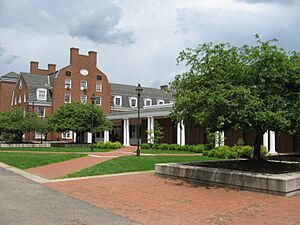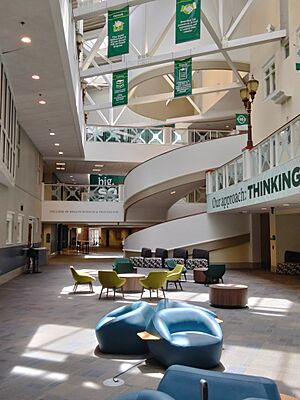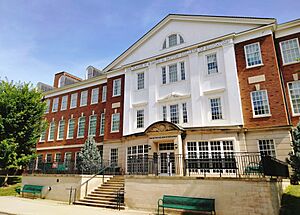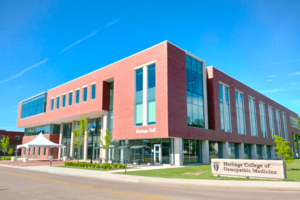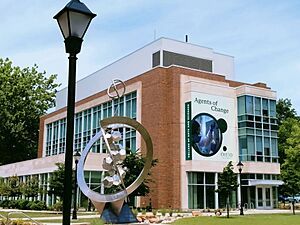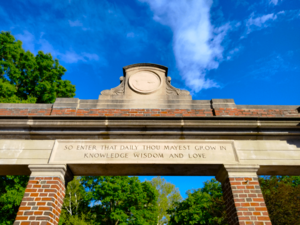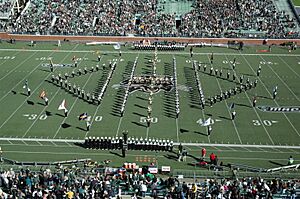Ohio University facts for kids
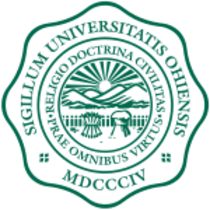 |
|
| Motto | Religio Doctrina Civilitas, Prae Omnibus Virtus (Latin) |
|---|---|
|
Motto in English
|
"Religion, Learning, Civility; Above All, Virtue" |
| Type | Public research university |
| Established | February 18, 1804 |
|
Parent institution
|
University System of Ohio |
| Accreditation | HLC |
|
Academic affiliations
|
|
| Endowment | $802.1 million (April 2025) |
| President | Lori Stewart Gonzalez |
| Provost | Donald J. Leo |
|
Academic staff
|
1,970 |
| Students | 18,502 (Athens) 28,270 (all campuses) |
| Undergraduates | 14,346 (Athens) 18,293 (all campuses) |
| Postgraduates | 4,156 (Athens) 998 (Medical school) 5,154 (all campuses) |
| Location |
,
,
United States
39°19′26″N 82°06′07″W / 39.324°N 82.102°W |
| Campus | Distant town, 1,850 acres (750 ha) |
| Other campuses |
|
| Newspaper | The Post |
| Colors | Cutler Green & Cupola White |
| Nickname | Bobcats |
|
Sporting affiliations
|
NCAA Division I FBS – MAC |
| Mascot | Rufus the Bobcat |
 |
|
Ohio University (also called Ohio or OU) is a public research university. Its main campus is in Athens, Ohio, United States. The idea for the university started in 1787. This was when the U.S. government set aside land to support a university.
The state of Ohio officially approved the university in 1804. It opened its doors to students in 1809. Ohio University was the first university created in the area known as the Northwest Territory.
Ohio University has nine campuses and many colleges. It offers over 250 different study programs. These include degrees for undergraduate, master's, and doctoral students. It is part of the University System of Ohio.
The university is known for its high level of research. As of fall 2020, about 18,000 students attended the Athens campus. Over 30,000 students attended all campuses combined.
Ohio's sports teams are called the Bobcats. They play in the National Collegiate Athletic Association (NCAA) at the top Division I level. They are founding members of the Mid-American Conference. The football team has played in 16 bowl games. The men's basketball team has been in the NCAA Division I basketball tournament 14 times. Their most recent appearance was in 2021.
Contents
University History and Growth
How Ohio University Started

The idea for a university in the Ohio Country came from Manasseh Cutler. He is known as the school's founder, along with Rufus Putnam. Putnam was also one of the first leaders of the university.
In 1797, settlers chose Athens as the school's location. It was between the capital, Chillicothe, and Marietta. The state of Ohio officially recognized Ohio University on February 18, 1804.
The first three students started classes in 1809. The first two bachelor's degrees were given out in 1815.
From the 1800s to Today
Ohio University was closed for a few years between 1843 and 1848. Women were first allowed to attend the university in 1868. In 1874, the state created Ohio State University in Columbus.
Some people wanted to make Ohio University a smaller school. But in 1896, a bill was passed that gave the university yearly support from the state. This helped Ohio University continue to grow.
The 1900s brought a lot of growth. Student numbers, classes, and research facilities all increased. Between 1955 and 1970, the number of undergraduate students tripled. The campus also grew with new dorms and buildings.
In 1964, U.S. President Lyndon B. Johnson spoke at the university. He talked about his "Great Society" plan. This brought national and international attention to Ohio University.
In 1970, there were protests at Ohio University. These were against the Vietnam War. The campus closed on May 15. In 1975, Ohio University started its medical school. It is called the Heritage College of Osteopathic Medicine.
In 1979, Chubu University in Japan gave 175 cherry trees to Ohio University. The Ohio University Innovation Center, which helps new technology businesses, started in 1983. In 2012, the university changed its academic calendar from quarters to semesters.
Exploring the Campuses
Athens Main Campus
The main campus is in Athens, Ohio. It sits above the Hocking River. The buildings have an early American style. Campus construction began in 1812 with Manasseh Cutler Hall. This building is a national landmark. Its chimes ring every half hour until 9:00 PM. The original bell, over 200 years old, is still in the Cutler Hall Cupola.
College Green: The Heart of Campus
The historic College Green is a central grassy area. Important buildings like Cutler Hall are located here. Wilson Hall and McGuffey Hall are also on the Green. These three original buildings are featured in the university's logo. The College Green looks much like it did 200 years ago.
It was designed like traditional English and New England towns. Galbreath Chapel is also on the Green. Its spire looks like a church in London. Other buildings include Chubb Hall, Ellis Hall, and Templeton-Blackburn Memorial Auditorium.
The University Sundial is behind Galbreath Chapel. It shows where the first university building stood. The College Green has two main entrances. Alumni Gateway, built in 1915, has a special message. It says, "That thou Mayest Grow In Knowledge, Wisdom and Love." The newer College Gate has words from the Northwest Ordinance of 1787.
A tradition for new students is to march onto the College Green. They are led by the Ohio University Marching 110. A large fair is held there for students to find clubs.
Baker University Center: Campus Hub
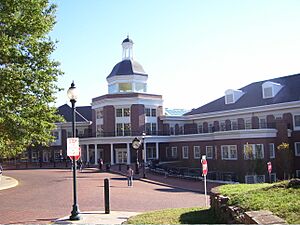
The John Calhoun Baker University Center opened in 2007. It is named after the university's 14th president. This building is the main activity center on campus. It has a classic red brick and white column look outside. Inside, it is modern with high ceilings.
Baker Center has a large food court called West 82. There is also a pub bistro called Latitude 39. It includes a Grand Ballroom and The Honors Collegium. The Bobcat Depot sells clothes and computers. There is also a theater, study areas, and computer labs.
The Front Room is a popular coffee shop. It has a stage and a fireplace. It is on the fourth floor with an outdoor terrace. Other features include a Post Office and the Trisolini Art Gallery.
East Green: Residential Life
East Green has twelve residence halls. It is the oldest residential area on campus. It has some of the steepest walkways. These paths help students get to classrooms. East Green also has Shively Court, a dining hall. Jefferson Marketplace offers several food options.
South Green: Sports and More
South Green is near Emeriti Park and the Hocking River. It has eighteen residence halls. Four new halls were added in 2015.
Key facilities on South Green include:
- Nelson Court: The largest dining hall with a market and coffee shop.
- Peden Stadium: The university's football field. It is the oldest football venue in its conference. It is an Official Ohio Historical Site.
- Bird Ice Arena: Home to the hockey team and for ice skating.
- Ohio University Aquatic Center: For the swimming and diving teams.
West Green: Engineering and Athletics
West Green is on the western side of campus. The Ohio Athletic Mall is here. It has fields for lacrosse, baseball, and track. Along the Hocking River, there are sakura (cherry blossom) trees. These were a gift from Chubu University of Japan. Students hold an annual "Sakura Festival."
Bicentennial Park has a landscape artwork called Input by artist Maya Lin. The Stocker Center is on West Green. It houses the Russ College of Engineering and Technology.
There are eight residence halls on West Green. Other facilities include:
- The District on West Green: A dining hall with many food choices.
- Academic and Research Center.
- Ohio Softball Field: Home to the softball team.
- Goldsberry Track: For the track and field teams.
- Bob Wren Stadium: Home to the baseball team.
- Chessa Field: For the women's soccer team.
- Pruitt Field: For the field hockey team.
Other Important Places
- The Ridges: This old mental hospital was bought by the university. It now has classrooms and offices. It is surrounded by a large nature preserve. A new observatory is also nearby.
- Gordon K. Bush Airport: The university's airport.
- Edwards Accelerator Laboratory: A particle accelerator for science research.
- The Athena Cinema: An old movie theater owned by the university.
- Lausche Heating Plant: Provides heat to all campus buildings.
Regional Campuses Across Ohio
Ohio University has five regional campuses. The first, Ohio University – Chillicothe, opened in 1946. It helped with overcrowding after World War II. Today, over 9,800 students attend these campuses:
- Ohio University Chillicothe – 1946
- Ohio University Zanesville – 1946
- Ohio University Lancaster – 1956
- Ohio University Southern (Ironton) – 1956
- Ohio University Eastern (St. Clairsville) – 1957
The Heritage College of Osteopathic Medicine also has two other campuses:
How Ohio University is Organized
The Athens campus has 12 colleges and schools that grant degrees. It also has the Ohio University Libraries and other support services. The College of Arts & Sciences is the largest. It offers many courses in subjects like history, social studies, and science. These courses are the base for all undergraduate degrees.
The Russ College of Engineering and Technology has highly-rated engineering programs. It is named after Fritz J. Russ, an electrical engineering graduate.
The Scripps College of Communication has five schools. These include the E.W. Scripps School of Journalism and the School of Visual Communication. It also has the Game Research and Immersive Design (GRID) Lab.
The College of Business offers nine different majors. It also has a general business minor. All business classes are taught by professors.
The College of Fine Arts has programs in art, dance, film, music, and theater. The Ohio University School of Music celebrated 100 years in 2017. The Kennedy Museum of Art is located at The Ridges.
The Patton College of Education started in 1886. It was the first state-supported teacher training program in Ohio. Today, it has three departments. It serves over 2,100 undergraduate and 800 graduate students.
The Honors Tutorial College offers special programs in 34 subjects. It is based on the British tutorial system. This means students learn one-on-one or in small groups.
The Heritage College of Osteopathic Medicine was created in 1975. It is the only college in Ohio that awards the Doctor of Osteopathic Medicine (D.O.) degree. In 1993, Barbara Ross-Lee became its dean. She was the first African-American woman to lead a U.S. medical school. The college opened new campuses in Dublin (2014) and Cleveland (2015).
The College of Health Sciences and Professions started in 1979. It includes departments like nursing, physical therapy, and social work.
University College was created in 2004. Students here can design their own major.
Research and Discovery Centers
Ohio University has many research programs. These allow students to learn from active scientists. The university's research centers cover many different fields.
The College of Arts & Sciences supports institutes like the Astrophysical Institute. It also has the Nanoscale and Quantum Phenomena Institute. The Center for International Studies was started in 1964.
The Heritage College of Osteopathic Medicine supports the Edison Biotechnology Institute.
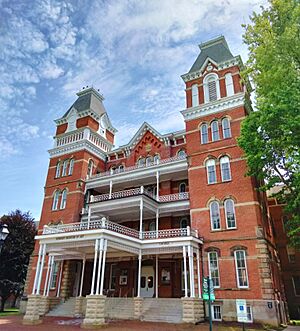
In Engineering and Technology, Ohio supports the Institute for Sustainable Energy and the Environment. It also has the Avionics Engineering Research Center.
The College of Business supports centers for eBusiness and International Business. It also has a business incubator.
The Scripps College of Communication supports the Scripps Survey Research Center. It also has the Game Research and Immersive Design (GRID) Lab. This lab helps students learn about digital game technology.
In Education, Ohio supports the Child Development Center.
University Libraries
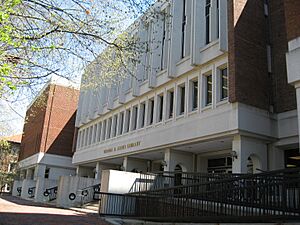
Vernon R. Alden Library is the main library on the Athens campus. It has research librarians to help students. Smaller libraries serve different departments. The Ohio University Press is also in Alden Library.
Each regional campus has its own library. Ohio University's library has over 4 million printed books. It also has 2.3 million microfilm items. This makes it one of the 100 largest libraries in the U.S. Alden Library was the first in the world to create an electronic library record in 1971.
The library has special collections of rare books. This includes a 14th-century Gutenberg Bible. Laptops are available for students to borrow. Outside Alden Library is Wolfe Garden. It is shaped like the state of Ohio and has native plants.
Campus Safety and Law Enforcement
Ohio University has its own police department (OUPD). It has 31 sworn officers and other staff. They have patrol and investigation teams. They also have K9 units and a SWAT team. OUPD is a certified law enforcement agency.
Academics and Learning
Ohio University has thirteen colleges and centers that grant degrees. The university's honor code includes ideas like character, citizenship, and community. New students formally enter the university with a special convocation. They march under the Alumni Gateway.
The university is known for its liberal arts programs. Its journalism, business, and medicine programs are also well-known. Most students come from the Mid-Atlantic and Midwest U.S. and from public high schools.
Admission to the university is selective. Some schools, like journalism, have extra requirements. The Heritage College of Osteopathic Medicine is the most selective college. Ohio University is recognized for its high research activity.
The Chronicle of Higher Education has named Ohio University a top producer of U.S. Fulbright scholars. This means many students receive special grants to study abroad. Since 2008, many students have won important scholarships. One alumnus even shared a Nobel Prize.
Becoming an Ohio University Student
| Admissions statistics | |
|---|---|
|
2023 entering
classChange vs. 2018 |
|
| Admit rate | 84.96%
(
|
| Yield rate | 20.94%
(
|
| Test scores middle 50% | |
| SAT Total | 1100–1280 (among 13% of FTFs) |
| ACT Composite | 22–28 (among 37% of FTFs) |
The Princeton Review gives Ohio University a high "Admissions Selectivity Rating." The university accepts about 85% of all applicants each year. They look at grades, recommendations, essays, and high school performance. Test scores are optional.
The Class of 2026 was Ohio University's largest class ever. Students came from all 50 states.
|
|
|
||||||||||||||||||||||||||||||||||||||||||||||||||||||||||||||||||||||||||
Student Life and Campus Fun
| Race and ethnicity | Total | ||
|---|---|---|---|
| White | 81% |
|
|
| Black | 6% |
|
|
| Other | 6% |
|
|
| Hispanic | 4% |
|
|
| Asian | 2% |
|
|
| Foreign national | 2% |
|
|
| Economic diversity | |||
| Low-income | 26% |
|
|
| Other | 74% |
|
|
University Traditions
Marching 110 Band: A Musical Powerhouse
The Ohio University Marching 110 is the official marching band. It started in 1923. The "110" refers to the band's original number of members. Today, there are about 225 members. The band performs at sports events and other activities.
In 1976, the Marching 110 was the first college marching band to play at Carnegie Hall. They also performed in Bill Clinton's first parade in Washington, D.C., in 1993. Other big performances include the Macy's Thanksgiving Day Parade and the 2010 Rose Parade.
Fun Campus Events
Athens has a famous annual Halloween block party. Ohio University helps support this event. Students also enjoy Homecoming Weekend. This includes a big parade and activities with alumni.
International Week in the Spring has another colorful parade. The Student Activities Commission (SAC) holds a yearly concert. Other traditions include the Kissing Circle on College Green. This is where couples kiss to make a "Bobcat Bond." April is also a month for environmental awareness programs.
Community Service and Giving Back
Students at Ohio University are involved in many service events. The Community Service Leadership Council organizes a "Project of the Week." These projects help local groups like Good Earth Farms and Habitat for Humanity.
Charity events include flag football tournaments and fun runs. These raise money for local health and food programs. In 1962, President Vernon Alden started programs to train Peace Corps volunteers. Today, Ohio University still has a Peace Corps recruiting office.
Campus Media and News
The university runs the Ohio University Press, which publishes books. Students also run a newspaper, TV, and radio stations. The main newspaper is The Post. It publishes online daily and in print weekly. It is independent from the university.
Ohio University Public Television is a PBS station. It broadcasts on WOUB Athens. It shows national PBS programs and student-produced news. Newswatch is a nightly news show with student reporters. Other student shows include Gridiron Glory and Bobcat Blitz.
WOUB-FM and other radio stations broadcast programs across southeastern Ohio. ACRN ("The Rock Lobster") is a student-run online radio station. The Ohio University Amateur Radio Club (W8PZS) is a ham radio club.
The New Political is an online publication about campus and state politics. Thread Magazine is a fashion magazine. Backdrop is about pop culture. Both are written by students. OHIO Today is the official magazine for alumni. The university also publishes the OHIO News page.
University Athletics
Ohio University sports began in 1894 with a football game. The university competes in the National Collegiate Athletic Association (NCAA) at the top Division I level. It is a founding member of the Mid-American Conference (MAC). The university has six men's teams and eight women's teams.
In 2012, Ohio University's men's basketball team beat Michigan in the NCAA tournament. They reached the "Sweet Sixteen" for the first time since 1964. All university sporting events are free for students. Ohio's team colors are hunter green and white. The mascot is Rufus the Bobcat. A statue of Rufus is at the entrance to Peden Stadium.
Basketball: On the Court
The 13,080-seat Convocation Center is home to the men's and women's basketball teams. It also hosts women's volleyball.
The first Ohio basketball game was in 1907. Since then, Ohio has a strong winning record. The Bobcats have won 7 MAC tournament titles. Their most recent was in 2021. They have also won 10 MAC regular-season titles.
Ohio has played in the NCAA tournament 14 times. Their most recent appearance was in 2021. The team has also played in the National Invitation Tournament 5 times. The program was ranked 86th in Street & Smith's 100 Greatest Basketball Programs of All Time in 2005.
The women's team has won three MAC Tournaments. They reached the NCAA Tournament in those years. They were the first team to win 30 games in the 2018-19 season.
Football: On the Field
Ohio Bobcats football started in 1894. They recently won against the Georgia Southern Eagles in the 2023 Myrtle Beach Bowl. They also had a big win over Iowa State University in 2023.
Peden Stadium, built in 1929, is the oldest football venue in the MAC. It can hold 27,000 fans. It is nicknamed "The Wrigley Field of College Football." The stadium had its largest crowd in 2012.
The Bobcats have won five MAC Football championships. They also won six Buckeye Athletic Association championships before joining the MAC. In 1960, they were named National Small College Champions. The Bobcats have played in several bowl games. They won their first bowl game in 2011. They also won the 2022 Barstool Sports Arizona Bowl in overtime.
Club Sports for Everyone
Ohio University has 36 active club sports programs. These are run by the Department of Campus Recreation. Club sports include teams for all genders, including co-ed sports.
Famous People from Ohio University
Ohio University has over 300,000 living former students. These include presidents of countries, Nobel Prize winners, and senators. Pulitzer Prize winners, generals, and astronauts are also among them.
Some famous alumni include:
- Jericka Duncan: A news anchor for CBS.
- Steve Newman: A "Worldwalker" who walked around the world.
- Loring Miner: The person who discovered the Spanish flu.
- Venkatraman Ramakrishnan: A Nobel Prize winner in Chemistry.
- George Voinovich: A former Ohio governor and U.S. senator.
- Thomas Ewing: The first graduate of Ohio University. He was also the first Secretary of the Interior.
Many alumni from the Scripps College of Communication have won or helped win Pulitzer Prizes.
See also
 In Spanish: Universidad de Ohio para niños
In Spanish: Universidad de Ohio para niños


